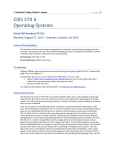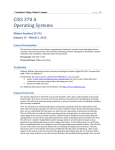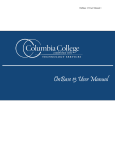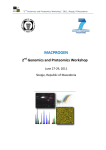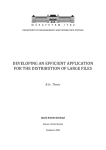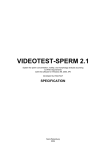Download BIOL 108L DEA Human Biology Lab
Transcript
Columbia College Online Campus Page |1 BIOL 108L DEA Human Biology Lab March 2015 Session 14-54 Monday, March 23 - Saturday, May 16, 2015 Course Description Laboratory experiences to complement BIOL 108. This course is intended for non-majors and those majors who need an introductory course before enrolling in BIOL 110. You are required to purchase an at-home lab kit. Access to the lab reading and supplemental materials will be provided through the D2L Content area. In addition, access to a digital camera is required for submitting photos electronically to the instructor. Prerequisite: BIOL 108 or concurrent enrollment. BIOL 108 must be completed before BIOL 108L can be used for general education credit. Proctored Exams: None Textbooks You are required to order an at-home Lab Kit. Kits may be purchased from MBS. In addition, students are responsible for gathering weekly supplies for labs. These will be readily available at your local supermarket. Important! Please do not order your Lab Kit until you are certain you will take this course. Lab Kits, if eligible for a refund, may be returned for refund only under very strict conditions, within only two (2) weeks of receipt. So, please do not order your Lab Kit until you are committed to taking this course! In addition, access to a digital camera is required for submitting photos electronically to the instructor. The Lab Kit for the course may be ordered from MBS Direct. You can order online at http://direct.mbsbooks.com/columbia.htm (be sure to select Online Education rather than your home campus before selecting your class) by phone at 800-325-3252 For additional information about the bookstore, visit http://www.mbsbooks.com. Course Overview Welcome to BIOL 108 Human Biology Laboratory, online! This course will introduce you to hands-on approaches for studying scientific reasoning, basic human cellular structure and function, human organ systems, genetics and reproduction, and how humans interact with their environment. Each week we will focus on different issues and concepts relating to the human body through our at-home laboratory kit, with additional online activities and discussions that will reinforce and expand on lab content. Hopefully when this class is finished, you will have a good basic understanding of human Columbia College Online Campus Page |2 biology and health. We will cover the following topics: Week 1 – Setting up a Safe Lab Week 2 – The Scientific Method; Introduction to the Microscope Week 3 – Biological Macromolecules; Comparative Cell Membranes and Transport; Week 4 – Tissues, Organs, and Homeostasis Week 5 – Cardiovascular System: The Heart Week 6 - Mitosis and Meiosis; Human Genetics and Karyotyping Week 7 –Human Reproduction (NOVA Life’s Greatest Miracle movie); Cloning case study Week 8 –Human Populations; Ecological Footprints Technology Requirements Participation in this course will require the basic technology for all online classes at Columbia College: A computer with reliable Internet access, a web browser, Acrobat Reader, Microsoft Office or another word processor such as Open Office. You can find more details about standard technical requirements for our courses on our site. Digital Photo Documentation Capability: Most of your lab reports will require digital photographs to document various steps of the experiments, or shown hand-drawn observations. You must have digital photography capability. (Also See “Photo Documentation” in the Assignment Overview Section.) Course Objectives To demonstrate basic laboratory techniques of experimentation and measurement using exercises which complement topics covered in BIOL 108 lecture. To practice scientific reasoning and methods. To examine basic characteristics common to all life forms. To examine basic human structure and function. To describe how humans have evolved. To describe how living organisms interact with their environment. Measurable Learning Outcomes Describe and use the scientific method. Recognize basic structures and functions of cells. Demonstrate basic genetic crosses. Explain the basis for several human genetic diseases. Columbia College Online Campus Page |3 Define biotechnology and give examples of its use. Describe the structure and function of one or more human organ systems. Define evolution and list the evidence for evolution. Apply population concepts to human populations. Study the components of an ecosystem. Describe how humans impact their environment. Grading Grading Scale Grade Weights GRADE POINTS PERCENT ASSIGNMENT POINTS PERCENT A 369-410 90-100 Discussion 110 27% B 328-368 80-89 Dropbox Assignments (Lab Report Assistants, Case Studies, Quizzes, Etc.) C 287-327 70-79 300 73% D 246-286 60-69 F 0-245 0-59 TOTAL 410 100% Schedule of Due Dates WEEK ASSIGNMENT POINTS DUE DATE 10 Thurs LabPaq Contents List 10 Thurs Safety Quiz 15 Sun “Signed” Lab Safety Contract 5 Sun Photo Set Lab 1 5 Sun 10 Thurs Pre-lab Hazard Assessment 10 Wed Lab Report Assistant 15 Thurs Photo Set Lab 2 5 Thurs 10 Sun 15 Sun 10 Thurs Pre-lab Hazard Assessment 10 Wed Lab Report Assistant 15 Thurs Lab 1: Setting up a Safe Lab Discussion 1: Describe your Home Lab Dropbox Assignments: 1 Lab 2: The Scientific Method Discussion 2: Post-lab Reflection Dropbox Assignments: 2 Lab 3: Introduction to the Microscope Discussion 3: Post-lab Reflection Dropbox Assignment: Microscope Post-lab Report Lab 4: Biological Macromolecules Discussion 4: Post-lab Reflection 3 Dropbox Assignment: Columbia College Online Campus Photo Set Lab 3 Page |4 5 Thurs 10 Sun Pre-lab Hazard Assessment 10 Sat Lab Report Assistant 15 Sun Photo Set Lab 4 5 Sun 10 Sun 20 Sun 10 Sun Pre-lab Hazard Assessment 10 Sat Lab Report Assistant 20 Sun 10 Thurs 20 Thurs 10 Sun 20 Sun 10 Thurs NOVA Post-movie Questions 15 Thurs Fetal Alcohol Syndrome Questions 15 Thurs Cloning Case Study 15 Sun Discussion 11: Post-lab Reflection 10 Sat Discussion 12: Ecological Footprint 10 Sat 15 Sat Lab 5: Comparative Cell Membranes and Transport Discussion 5: Post-lab Reflection Dropbox Assignment: Lab 6: Tissues, Organs and Homeostasis 4 Discussion 6: Post-lab Reflection Dropbox Assignment: Lab Report Assistant Lab 7: Cardiovascular System: The Heart Discussion 7: Post-lab Reflection 5 Dropbox Assignment: Lab 8: Mitosis and Meiosis Discussion 8: Post-lab Reflection Dropbox Assignment: 6 Lab Report Assistant Lab 9: Human Genetics and Karyotyping Discussion 9: Post-lab Reflection Dropbox Assignment: Lab Report Assistant Lab 10: Human Reproduction Discussion 10: Reproduction 7 Dropbox Assignment: Lab 11: Human Populations 8 Dropbox Assignment: Human Populations Lab Report TOTAL 410 Assignment Overview Each student is responsible for: Completing weekly reading assignments. Answering weekly discussion questions and responding to your classmates Columbia College Online Campus Page |5 Completing lab reports and post-lab questions Submitting photo documentation Readings can be found in the Content area of D2L. These should be completed prior to submitting assignments or weekly discussion postings. All graded assignments will rely on information derived from the text. Discussion: Discussion postings should be completed by Thursday or Sunday of each assigned week depending on the lab schedule (with the exception of Week 8, when all assignments are due on the final day of the course). Discussion postings will be graded according to the rubric provided in the Grading Criteria section below. Dropbox Assignments must be completed and posted to the appropriate folder in the Dropbox area of the course by the due dates listed above. Dropbox assignments are graded according to the rubric provided in the Grading Criteria section below. Dropbox Assignment descriptions are as follows: Lab Report Assistants are required for most labs. Under Content for each week, open the Lab Report Assistant for the lab. This basically includes all the questions and tables that you should fill out as you work your way through the lab. As you complete the lab, fill out these questions, data tables, graphs, etc. Each Lab Report Assistant should be submitted to the appropriate folder in the Dropbox no later than the assigned due date. During weeks when TWO labs will be completed, the first lab will be conducted Monday through Thursday, and the second lab will be conducted Thursday through Sunday. Check the schedule above for specific due dates for quizzes, assignments, and discussion questions. Photo Sets: Photo documentation is required for certain steps of most labs. Required photos include documenting various steps of the experiments, hand-drawn observations, or personal observations. Digital photos should be pasted into the appropriate place on the Lab Report Assistant, or for additional photos not specifically required in the lab procedure, should be placed into a single Word document. In the Content area of the course, you will find a document called Required Photo Sets. This is a week-by-week list of required photos to be submitted based on each lab. The required photos that are specific steps of an experiment should be embedded directly into the Lab Report Assistant. All others should be submitted as a Word document to the dropbox each week. Pre-lab Hazard Assessments: Some labs will require a Pre-lab Hazard Assessment to be completed. Use the Prelab Hazard Assessment Template provided under General Course Information to complete these assignments. This assessment involves reviewing possible safety hazards for each lab, researching any potentially harmful chemicals using the MSDS information provided, and writing a brief summary of each hazard. Each Pre-lab Hazard Assessment should be submitted to the appropriate folder in the Dropbox no later than the assigned due date. Other Dropbox Assignments: Lab Safety Agreement, Safety Quiz, LabPaq Contents List, Microscope Post-lab Report, NOVA Post-movie Questions, Fetal Alcohol Syndrome Questions, Cloning Case Study, and Human Populations report. These should all be completed according to the instructions provided in the syllabus and course. All must be submitted to the appropriate folder in the Dropbox area of the course by each assigned due date. Columbia College Online Campus Page |6 Course Schedule Week 1 – Setting up a Safe Lab Activities: Complete the following activities. Weekly Shopping List: In the Content area of the course, you will find a document called “Student Shopping List”. This is a week-by-week list of supplies that you must provide. Print this off and make sure to find or purchase supplies needed for each week. Lab 1: Setting up a safe lab Readings: Complete the following readings from the Content area. General Course Information: Please review the Introduction, Weekly Required Photo Sets, Syllabus, Student Shopping List and the Prelab Hazard Assessment template. Safety Information: from this module, read Safety Information and the Safety Contract. Appendices: In this module you will find a lot of general information. Please make note of Specimen Care, Final Cleanup, How to Handle Preserved Specimens, and the files dealing with technical help for images, etc. Other Readings: Read the Week 1 Overview, and any Instructor Notes for this lab, located in the Content area of the course. Activities: Open your kit and examine the contents. Also, watch the safety video provided by LabPaq available in the Content area. Dropbox Assignments: Complete the following and submit each to their corresponding folders in the Dropbox area of the course. Confirm the due date of each assignment on the Schedule of Due Dates table above. LabPaq Contents List: Watch Unpacking Your Kit, found in the Video module under course Content. Using the Contents List provided with your kit, remove each item from the kit and check it off the list. Also, at the beginning of each lab in the lab readings, locate the Materials list. Check the ‘LabPaq Provides’ list and make sure that it aligns with the kit Content List. Complete your check of the LabPaq Contents List. Make sure it is checked and initialed. Scan or photograph the initialed sheet and submit to the appropriate dropbox. Lab Safety Contract: In the Content area of the course under Safety, you will find a Lab Safety Contract. Read this document, and initial and “sign”. Submit to the appropriate dropbox. Safety Quiz: Under course Quizzes you will find the “Safety Quiz”. Complete this quiz and submit. Photo Set Lab 1: For this lab, submit a photo of you with your kit in your home lab. Discussion 1: Describe your home laboratory. Why did you choose this area? What are the potential problems with using this area? How might you resolve those problems? Week 2 – The Scientific Method/Introduction to the Microscope Lab 2: The Scientific Method Readings: Complete the following readings under course Content for this week. Week 2: From this module, read the Overview, Prelab Instructor Notes, and The Scientific Method lab. Columbia College Online Campus Page |7 Other Readings: Read the User’s Manual for the Digital Scale, which can be found in the scale. Activities: After reading the lab and completing the pre-lab hazard assessment, go through the lab kit and find all items listed as needed. Also, gather any supplies listed under “student provides.” Once all materials are laid out, you can begin the lab. For this lab, you will follow the steps of the Scientific Method (question, hypothesize, experiment, compile data, and draw conclusions) to predict and then identify 6 unknown substances. Dropbox Assignments: Complete the following and submit each to their corresponding folders in the Dropbox area of the course. Confirm the due date of each assignment on the Schedule of Due Dates table above. Pre-lab Hazard Assessment: Using the Prelab Hazard Assessment Template found under General Course Information, review potential hazards of this lab, both chemical and physical. Lab Report Assistant: Under Content, locate the Lab Report Assistant for the Scientific Method Lab. This report includes all the questions and tables that you should complete as you work your way through the lab. As you complete the lab, fill out these questions and tables. Finally, type your writings onto the Lab Report template. Photo Set 2: In addition to any photos required as a part of the Lab Report Assistant, submit a photo of each of the following: (1) all materials for the lab laid out on your work surface prior to the experiment and (2) the results of the solubility test (the 6 test tubes). Paste these photos into a single Word document. Discussion 2: Post-lab reflection: What worked? What problems did you encounter? What might you do differently if you were to do this again? What insights did you gain about the scientific method? Lab 3: Introduction to the Microscope Readings: Read the Introduction to the Microscope Lab located in the Content area of the course, as well as Operating Instructions for the Pocket Microscope. Activities: In this lab, you will become familiar with the field microscope that came with your kit. Since there is no lab in your lab manual that directly addresses the microscope, I have provided this supplemental lab for you to complete. In this lab, you will first learn the parts of your microscope, and also of an actual light microscope that might be used in a laboratory. You will also make some slides of your own in order to study properties of the microscope. You will practice viewing a letter “e” slide virtually on a compound microscope. Dropbox Assignments: Complete the following and submit each to their corresponding folders in the Dropbox area of the course. Confirm the due date of each assignment on the Schedule of Due Dates table above. Lab Report for the Introduction to the Microscope: Read the Introduction to Microscope Lab reading, located in the Content area, and complete the report, including drawings and questions. Required Photo Documentation: The only required photos this week are the drawings completed with the Microscope Post-lab Report. Discussion 3: Post-lab reflection: What worked? What problems did you encounter? What might you do differently if you were to do this again? What insights did you gain about the microscope? Columbia College Online Campus Page |8 Week 3 – Biological Macromolecules/Comparative Cell Membranes and Transport Lab 4: Biological Macromolecules Readings: Under Week 3 Content, review the Overview and Prelab Instructor notes. Read the Biological Macromolecules lab. Activities: After reading the lab, complete a prelab hazard assessment. Next, go through the lab kit and find all items listed as needed in the lab. Also, gather any supplies listed under “student provides.” Once all materials are laid out, you can begin the lab. For this lab, you will be studying 3 of the 4 main macromolecules of life (proteins, sugars/starches, and lipids or fats). This lab teaches the simple qualitative tests for identifying these substances. Dropbox Assignments: Complete the following and submit each to their corresponding folders in the Dropbox area of the course. Confirm the due date of each assignment on the Schedule of Due Dates table above. Pre-lab Hazard Assessment: Using the template provided under General Course Information, review potential hazards of this lab, both chemical and physical. Lab Report Assistant: Under Content, open the Biological Macromolecules Lab Report Assistant. This report includes all the questions and tables that you should complete as you work your way through the lab. As you complete the lab, fill out these questions and tables. Type up your report, using the Lab Report template and submit it to the dropbox. Photo Set Lab 3: Submit a photo of each of the following: (1) the results of the protein test (your test tubes), (2) the results of your sugar test (your test tubes), (3) a photo of the drawings from the Observations Table: Exercise 3, and (4) the results of your lipid test. Paste your photos into a single Word document. Discussion 4: Post-lab reflection: What worked? What problems did you encounter? What might you do differently if you were to do this again? What insights did you gain? Lab 5: Comparative Cell Membranes and Transport Readings: Under Week 3 Content, read the Comparative Cell Membranes and Transport lab. Activities: After reading the lab and completing the prelab hazard assessment, go through the lab kit and find all items listed on the first page of the lab. Also, gather any supplies listed under “student provides.” Once all materials are laid out, you can begin the lab. For this lab, you will be studying the ways in which certain materials move across the plasma membrane of the cell, including the concepts of diffusion and osmosis. Dropbox Assignments: Complete the following and submit each to their corresponding folders in the Dropbox area of the course. Confirm the due date of each assignment on the Schedule of Due Dates table above. Columbia College Online Campus Page |9 Pre-lab Hazard Assessment: Using the template provided, review potential hazards of this lab, both chemical and physical. Lab Report Assistant: Open the Comparative Cell Membrane Transport Lab Report Assistant. This report includes all the questions and tables that you should complete as you work your way through the lab. As you complete the lab, fill out these questions and tables. Type up your report, using the Lab Report template and submit it to the dropbox. Photo Set 4: Submit a photo of each of the following: (1) photo of the diffusion through an artificial membrane during the 1-hour waiting period and (2) a photo of the results of the diffusion at different temperatures test. Paste your photos into a single Word document. Discussion 5: Post-lab reflection: What worked? What problems did you encounter? What might you do differently if you were to do this again? What insights did you gain about cell membranes? Week 4 – Tissues, Organs, and Homeostasis Lab 6: Tissues, Organs and Homeostasis Readings: Under Week 4 Content, review the Overview as well as the Prelab Instructor Notes. Read the Tissues, Organs and Homeostasis lab. Activities: After reading the lab, go through the lab kit and find all items listed on the first page of the lab. Also, gather any supplies listed under “student provides”. Once all materials are laid out, you can begin the lab. For this lab, you will be studying the main types of tissues in the human body (nervous, muscle, connective, and epithelial) and also the process of homeostasis. Dropbox Assignments: Complete the following and submit each to their corresponding folders in the Dropbox area of the course. Confirm the due date of each assignment on the Schedule of Due Dates table above. Lab Report Assistant: Open the Tissues, Organs and Homeostasis Lab Report Assistant. This report includes all the questions and tables that you should complete as you work your way through the lab. As you complete the lab, fill out these questions and tables. Type up your report, using the Lab Report template and submit it to the dropbox.. Photos: Photos and graph required for this lab should be embedded in the Lab Report Assistant. There is no separate submission required for this lab. Discussion 6: Post-lab reflection: What worked? What problems did you encounter? What might you do differently if you were to do this again? What insights did you gain? Week 5 – Cardiovascular System: The Heart Lab 7: The Heart Readings: Under Week 5 Content, review the Overview and Prelab Instructor Notes containing a set of dissection videos. Read Cardiovascular System: The Heart and view the images of Cardiac Muscle provided. Activities: After reading the lab and completing the prelab hazard assessment, go through the lab kit and find all items listed as needed for this lab. Also, gather any supplies listed under “student provides”. Once all materials are laid out, you can begin the lab. For this lab, you will be studying the structures and functions of the cardiovascular system, specifically the heart. You will be dissecting a sheep heart. Dropbox Assignments: Complete the following nd submit each to their corresponding folders in the Dropbox area of the course. Confirm the due date of each assignment on the Schedule of Due Dates Columbia College Online Campus P a g e | 10 table above. Pre-lab Hazard Assessment: Using the template provided, review potential hazards of this lab, both chemical and physical. Lab Report Assistant: Open the Cardiovascular System: The Heart Lab Report Assistant. This report includes all the questions and tables that you should complete as you work your way through the lab. As you complete the lab, fill out these questions and tables. Type up your report, using the Lab Report template and submit it to the dropbox Photos: Photos and drawings required for this lab should be embedded in the Lab Report Assistant. There is no separate submission required for this lab. Discussion 7: Post-lab reflection: What worked? What problems did you encounter? What might you do differently if you were to do this again? What insights did you gain? Week 6 – Mitosis and Meiosis/Human Genetics and Karyotyping Lab 8: Mitosis and Meiosis Readings: Under Week 6 Content, review the Overview and Prelab Instructor Notes. Read the Mitosis and Meiosis lab, and view the images of Onion Mitosis and Whitefish Mitosis provided. Activities: After reading the lab, go through the lab kit and find all items listed on the first page of the lab. Also, gather any supplies listed under “student provides.” Once all materials are laid out, you can begin the lab. For this lab, you will be studying cell division. Mitosis and meiosis are two similar but also very different ways in which cells divide. Dropbox Assignments: Complete the following and submit each to their corresponding folders in the Dropbox area of the course. Confirm the due date of each assignment on the Schedule of Due Dates table above. Lab Report Assistant: Open the Mitosis and Meiosis Lab Report Assistant. This report includes all the questions and tables that you should complete as you work your way through the lab. As you complete the lab, fill out these questions and tables. Type up your report, using the Lab Report template and submit it to the dropbox. Photos: Photos and drawings required for this lab should be embedded in the Lab Report Assistant. There is no separate submission required for this lab. Discussion 8: Post-lab reflection: What worked? What problems did you encounter? What might you do differently if you were to do this again? What insights did you gain? Course Evaluations: Please evaluate the course. You will be able to submit your course evaluation between Sunday of Week 5 and Thursday of Week 7. A link will be sent to your CougarMail that will allow you to access the evaluation. Lab 9: Human Genetics and Karyotyping Readings: Read the Human Genetics and Karyotyping lab. Activities: After reading the lab, go through the lab kit and find all items listed as needed for the lab. Also, gather any supplies listed under “student provides.” Once all materials are laid out, you can begin the lab. For this lab, you will be studying human traits and inheritance patterns. Dropbox Assignments: Complete the following and submit each to their corresponding folders in the Dropbox area of the course. Confirm the due date of each assignment on the Schedule of Due Dates table above. Columbia College Online Campus P a g e | 11 Lab Report Assistant: Open the Human Genetics Lab Report Assistant. This report basically includes all the questions and tables that you should complete as you work your way through the lab. As you complete the lab, fill out these questions and tables. Type up your report, using the Lab Report template and submit it to the dropbox. Photos: Photos and drawings required for this lab should be embedded in the Lab Report Assistant. There is no separate submission required for this lab. Discussion 9: Post-lab reflection: What worked? What problems did you encounter? What might you do differently if you were to do this again? What insights did you gain? Week 7 – Human Reproduction Lab 10: Human Reproduction Readings: “Fetal Alcohol Syndrome and Human Development,” and “Bringing back baby Jason: To clone or not to clone” located in the Content area of the course. Activities: We will be taking a break from laboratory exercises this week and instead viewing a movie, answering a set of questions, and completing two exercises related to human reproduction. Visit the link provided in the Content area and watch the 60-minute movie on human reproduction and fetal development. Dropbox Assignments: Complete the following and submit each to their corresponding folders in the Dropbox area of the course. Confirm the due date of each assignment on the Schedule of Due Dates table above. NOVA Post-movie questions: Open NOVA Life’s Greatest miracle available in the Content area. After viewing the movie online, complete the set of post-movie questions and submit them to the dropbox. Fetal Alcohol Syndrome Questions: Open the Fetal Alcohol Syndrome available in the Content area. Use the information provided and information from the movie to answer the listed questions and submit your answers to the dropbox. Cloning Case Study: Read the Cloning Case Study (“Bringing back baby Jason: To clone or not to clone”) available in the Content area. After reading the case study, open and complete the Cloning Case Study Questions. Submit your answers to the dropbox. Discussion 10: Genetic and environmental factors influence both male and female reproductive systems. What are some of the positive and negative environmental influences on sperm production and pregnancy, including nutrition, exercise, and exposure to chemicals? Week 8– Human Populations Lab 11: Human Populations Readings: Read the Human Population Lab located in the Content area. Activities: After reading the lab, open the Virtual Cemetery located in the Content area. For this lab, you will be collecting information from grave markers in order to study changing demographic patterns over time. You will also complete an Ecological Footprint Quiz and discuss how you have an impact on the environmental around you. Dropbox Assignments: Complete the following and submit each to their corresponding folders in the Dropbox area of the course. Confirm the due date of each assignment on the Schedule of Due Dates table above. Columbia College Online Campus P a g e | 12 Human Populations Lab Report: Open the Human Population Lab located in the Content area. For this lab, you will be collecting grave marker information for men and women based on year of birth. Open the Virtual Cemetery file and find as many graves as you can to complete Data Table I. Complete the Pre-lab Questions, all data tables, and the end-of-lab questions. Submit the completed lab to the dropbox no later than 11:59 p.m. CT Saturday. Discussion 11: Post-lab reflection: What worked? What problems did you encounter? What might you do differently if you were to do this again? What insights did you gain? Discussion 12: Visit the website provided in the Content area and complete the ‘Calculate your Ecological Footprint’ quiz. How many planets would you need assuming your current lifestyle? What about your lifestyle contributes the most towards you footprint? What one thing would be the easiest to change dramatically? Course Policies Student Conduct All Columbia College students, whether enrolled in a land-based or online course, are responsible for behaving in a manner consistent with Columbia College's Student Conduct Code and Acceptable Use Policy. Students violating these policies will be referred to the office of Student Affairs and/or the office of Academic Affairs for possible disciplinary action. The Student Code of Conduct and the Computer Use Policy for students can be found in the Columbia College Student Handbook. The Handbook is available online; you can also obtain a copy by calling the Student Affairs office (Campus Life) at 573-875-7400. The teacher maintains the right to manage a positive learning environment, and all students must adhere to the conventions of online etiquette. Plagiarism Your grade will be based in large part on the originality of your ideas and your written presentation of these ideas. Presenting the words, ideas, or expression of another in any form as your own is plagiarism. Students who fail to properly give credit for information contained in their written work (papers, journals, exams, etc.) are violating the intellectual property rights of the original author. For proper citation of the original authors, you should reference the appropriate publication manual for your degree program or course (APA, MLA, etc.). Violations are taken seriously in higher education and may result in a failing grade on the assignment, a grade of "F" for the course, or dismissal from the College. Collaboration conducted between students without prior permission from the instructor is considered plagiarism and will be treated as such. Spouses and roommates taking the same course should be particularly careful. All required papers may be submitted for textual similarity review to Turnitin.com for the detection of plagiarism. All submitted papers may be included in the Turnitin.com reference database for the purpose of detecting plagiarism. This service is subject to the Terms and Conditions of Use posted on the Turnitin.com site. Non-Discrimination There will be no discrimination on the basis of sex, race, color, national origin, sexual orientation, religion, ideology, political affiliation, veteran status, age, physical handicap, or marital status. Disability Services Students with documented disabilities who may need academic services for this course are required to register with the Coordinator for Disability Services at (573) 875-7626. Until the student has been Columbia College Online Campus P a g e | 13 cleared through the disability services office, accommodations do not have to be granted. If you are a student who has a documented disability, it is important for you to read the entire syllabus before enrolling in the course. The structure or the content of the course may make an accommodation not feasible. Online Participation You are expected to read the assigned texts and participate in the discussions and other course activities each week. Assignments should be posted by the due dates stated on the grading schedule in your syllabus. If an emergency arises that prevents you from participating in class, please let your instructor know as soon as possible. Attendance Policy Attendance for a week will be counted as having submitted a course assignment for which points have been earned during that week of the session or if the proctoring information has been submitted or the plagiarism quiz taken if there is no other assignment due that week. A class week is defined as the period of time between Monday and Sunday (except for Week 8, when the week and the course will end on Saturday at midnight). The course and system deadlines are all based on the Central Time Zone. Cougar E-mail All students are provided a CougarMail account when they enroll in classes at Columbia College. You are responsible for monitoring e-mail from that account for important messages from the College and from your instructor. You may forward your Cougar e-mail account to another account; however, the College cannot be held responsible for breaches in security or service interruptions with other e-mail providers. Students should use e-mail for private messages to the instructor and other students. The class discussions are for public messages so the class members can each see what others have to say about any given topic and respond. Late Assignment Policy An online class requires regular participation and a commitment to your instructor and your classmates to regularly engage in the reading, discussion and writing assignments. Although most of the online communication for this course is asynchronous, you must be able to commit to the schedule of work for the class for the next eight weeks. You must keep up with the schedule of reading and writing to successfully complete the class. No late assignments will be accepted without a penalty assessment unless there are truly extenuating circumstances beyond the control of the student. I will count off 20% of the total points possible for lab reports and photo documentation each day they are late (11:59 p.m. CT marks the end of a day). Late pre-lab quizzes will not be accepted. The instructor must be notified prior to the due date of the assignment if it will be late. Course Evaluation You will have an opportunity to evaluate the course near the end of the session. Course evaluations will open on Sunday of Week 5 and will remain open until Thursday of Week 7. A link will be sent to your CougarMail that will allow you to access the evaluation. Be assured that the evaluations are anonymous and that your instructor will not be able to see them until after final grades are submitted. Columbia College Online Campus P a g e | 14 Additional Resources Orientation for New Students This course is offered online, using course management software provided by Desire2Learn and Columbia College. The Student Manual provides details about taking an online course at Columbia College. You may also want to visit the course demonstration to view a sample course before this one opens. Technical Support If you have problems accessing the course or posting your assignments, contact your instructor, the Columbia College Helpdesk, or the D2L Helpdesk for assistance. Contact information is also available within the online course environment. [email protected] [email protected] 800-231-2391 ex. 4357 877-325-7778 Online Tutoring Smarthinking is a free online tutoring service available to all Columbia College students. Smarthinking provides real-time online tutoring and homework help for Math, English, and Writing. The Writing Center can be used for writing assistance in any course. Smarthinking also provides access to live tutorials in writing and math, as well as a full range of study resources, including writing manuals, sample problems, and study skills manuals. You can access the service from wherever you have a connection to the Internet. I encourage you to take advantage of this free service provided by the college. Access Smarthinking through CougarTrack under Students->Academics->Academic Resources. Grading Criteria Discussion Criteria Description Points Initial Response Answers are complete, concise, and demonstrate familiarity with the readings. 5 Response to Classmates Responses to classmates are substantive and help to advance the discussion and/or our understanding of the subject. Responses pose questions or respond to questions of classmates. At least two responses for each topic are required for full points. 3 Participation The number and timeliness of posts submitted and read. Those who post early and often contribute more to the discussion than those who post the minimum number of posts just before the deadline. 2 Lab Assistant Reports Criteria Description Content Report addresses all the necessary components and demonstrates mastery of the concepts and applications Points 10 Columbia College Online Campus P a g e | 15 Organization Report is well thought out and organized 3 Mechanics Report is well written; errors in spelling and grammar are rare. 2 Photo Sets (if required) Report includes appropriate photographs to document the lab. Photos clearly show the necessary elements, are well organized and have appropriate captions. 5

















